Managing Food and Beverage Operations: Current and Future Trends Affecting The Savoy Hotel
VerifiedAdded on 2023/06/16
|14
|4097
|422
AI Summary
This report discusses the different types of F&B businesses, rating systems used within F&B sector, current and future trends affecting The Savoy Hotel, and a comparison between different types of operational and marketing technology uses by various F&B businesses.
Contribute Materials
Your contribution can guide someone’s learning journey. Share your
documents today.
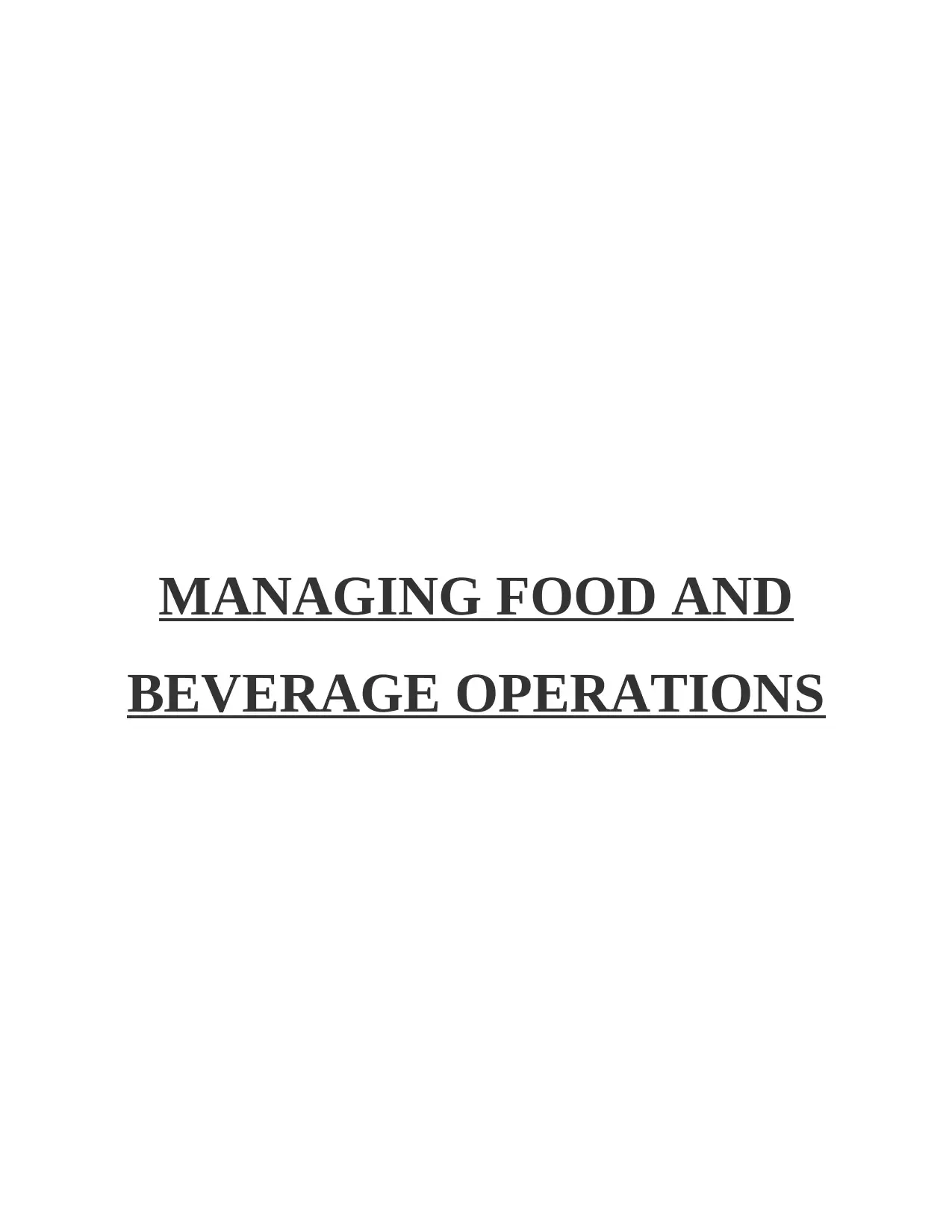
MANAGING FOOD AND
BEVERAGE OPERATIONS
BEVERAGE OPERATIONS
Secure Best Marks with AI Grader
Need help grading? Try our AI Grader for instant feedback on your assignments.

Table of Contents
LO 1.................................................................................................................................................3
P3 Currents and future trends affecting The Savoy Hotel...........................................................3
M1................................................................................................................................................4
D1.................................................................................................................................................4
LO 3.................................................................................................................................................4
P6 Comparison between different types of operational and marketing technology uses by
various F&B businesses...............................................................................................................4
M4................................................................................................................................................6
LO 4.................................................................................................................................................7
P7 Investigating the factors that influence the decision of consumers within Savoy Hotel........7
D3.................................................................................................................................................7
REFERENCES................................................................................................................................1
LO 1.................................................................................................................................................3
P3 Currents and future trends affecting The Savoy Hotel...........................................................3
M1................................................................................................................................................4
D1.................................................................................................................................................4
LO 3.................................................................................................................................................4
P6 Comparison between different types of operational and marketing technology uses by
various F&B businesses...............................................................................................................4
M4................................................................................................................................................6
LO 4.................................................................................................................................................7
P7 Investigating the factors that influence the decision of consumers within Savoy Hotel........7
D3.................................................................................................................................................7
REFERENCES................................................................................................................................1
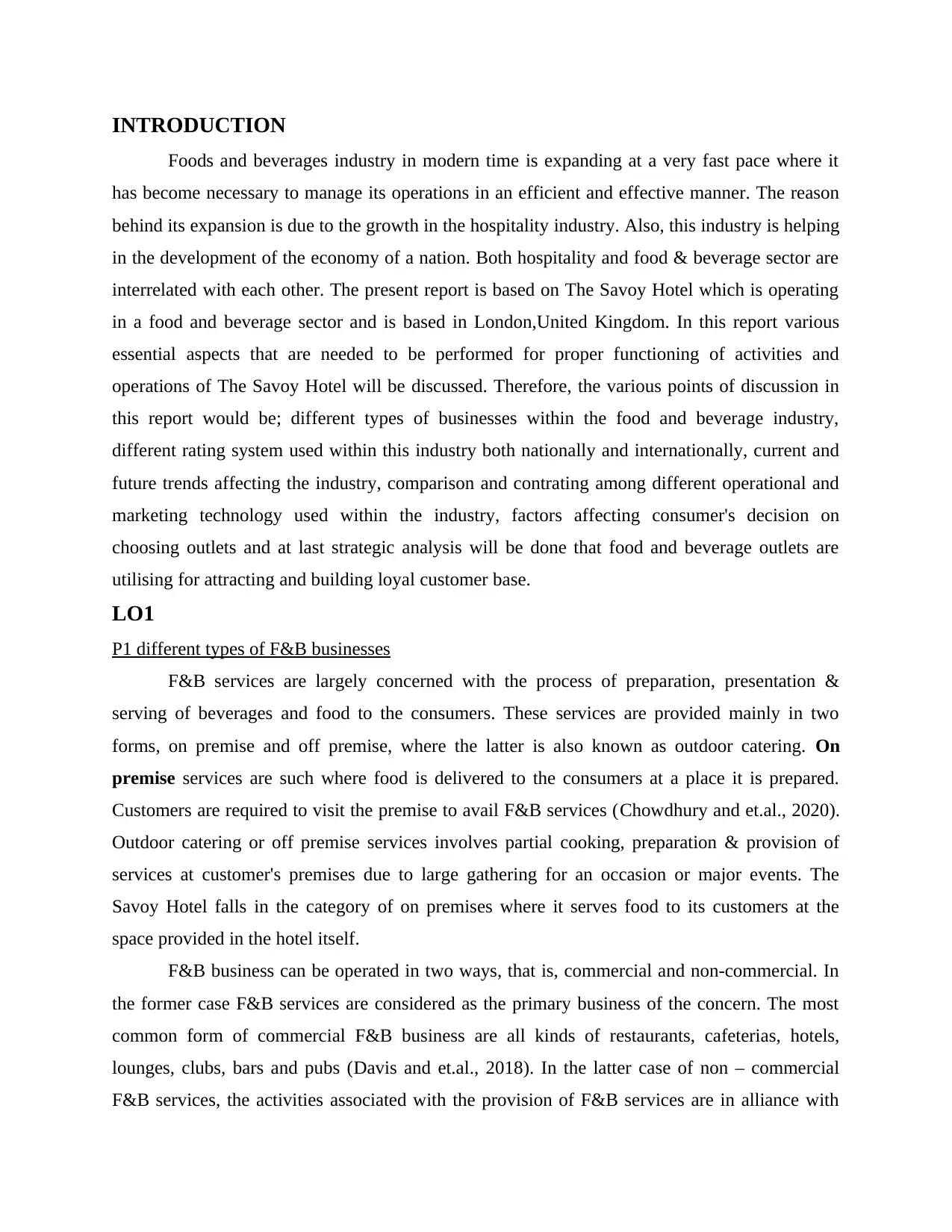
INTRODUCTION
Foods and beverages industry in modern time is expanding at a very fast pace where it
has become necessary to manage its operations in an efficient and effective manner. The reason
behind its expansion is due to the growth in the hospitality industry. Also, this industry is helping
in the development of the economy of a nation. Both hospitality and food & beverage sector are
interrelated with each other. The present report is based on The Savoy Hotel which is operating
in a food and beverage sector and is based in London,United Kingdom. In this report various
essential aspects that are needed to be performed for proper functioning of activities and
operations of The Savoy Hotel will be discussed. Therefore, the various points of discussion in
this report would be; different types of businesses within the food and beverage industry,
different rating system used within this industry both nationally and internationally, current and
future trends affecting the industry, comparison and contrating among different operational and
marketing technology used within the industry, factors affecting consumer's decision on
choosing outlets and at last strategic analysis will be done that food and beverage outlets are
utilising for attracting and building loyal customer base.
LO1
P1 different types of F&B businesses
F&B services are largely concerned with the process of preparation, presentation &
serving of beverages and food to the consumers. These services are provided mainly in two
forms, on premise and off premise, where the latter is also known as outdoor catering. On
premise services are such where food is delivered to the consumers at a place it is prepared.
Customers are required to visit the premise to avail F&B services (Chowdhury and et.al., 2020).
Outdoor catering or off premise services involves partial cooking, preparation & provision of
services at customer's premises due to large gathering for an occasion or major events. The
Savoy Hotel falls in the category of on premises where it serves food to its customers at the
space provided in the hotel itself.
F&B business can be operated in two ways, that is, commercial and non-commercial. In
the former case F&B services are considered as the primary business of the concern. The most
common form of commercial F&B business are all kinds of restaurants, cafeterias, hotels,
lounges, clubs, bars and pubs (Davis and et.al., 2018). In the latter case of non – commercial
F&B services, the activities associated with the provision of F&B services are in alliance with
Foods and beverages industry in modern time is expanding at a very fast pace where it
has become necessary to manage its operations in an efficient and effective manner. The reason
behind its expansion is due to the growth in the hospitality industry. Also, this industry is helping
in the development of the economy of a nation. Both hospitality and food & beverage sector are
interrelated with each other. The present report is based on The Savoy Hotel which is operating
in a food and beverage sector and is based in London,United Kingdom. In this report various
essential aspects that are needed to be performed for proper functioning of activities and
operations of The Savoy Hotel will be discussed. Therefore, the various points of discussion in
this report would be; different types of businesses within the food and beverage industry,
different rating system used within this industry both nationally and internationally, current and
future trends affecting the industry, comparison and contrating among different operational and
marketing technology used within the industry, factors affecting consumer's decision on
choosing outlets and at last strategic analysis will be done that food and beverage outlets are
utilising for attracting and building loyal customer base.
LO1
P1 different types of F&B businesses
F&B services are largely concerned with the process of preparation, presentation &
serving of beverages and food to the consumers. These services are provided mainly in two
forms, on premise and off premise, where the latter is also known as outdoor catering. On
premise services are such where food is delivered to the consumers at a place it is prepared.
Customers are required to visit the premise to avail F&B services (Chowdhury and et.al., 2020).
Outdoor catering or off premise services involves partial cooking, preparation & provision of
services at customer's premises due to large gathering for an occasion or major events. The
Savoy Hotel falls in the category of on premises where it serves food to its customers at the
space provided in the hotel itself.
F&B business can be operated in two ways, that is, commercial and non-commercial. In
the former case F&B services are considered as the primary business of the concern. The most
common form of commercial F&B business are all kinds of restaurants, cafeterias, hotels,
lounges, clubs, bars and pubs (Davis and et.al., 2018). In the latter case of non – commercial
F&B services, the activities associated with the provision of F&B services are in alliance with
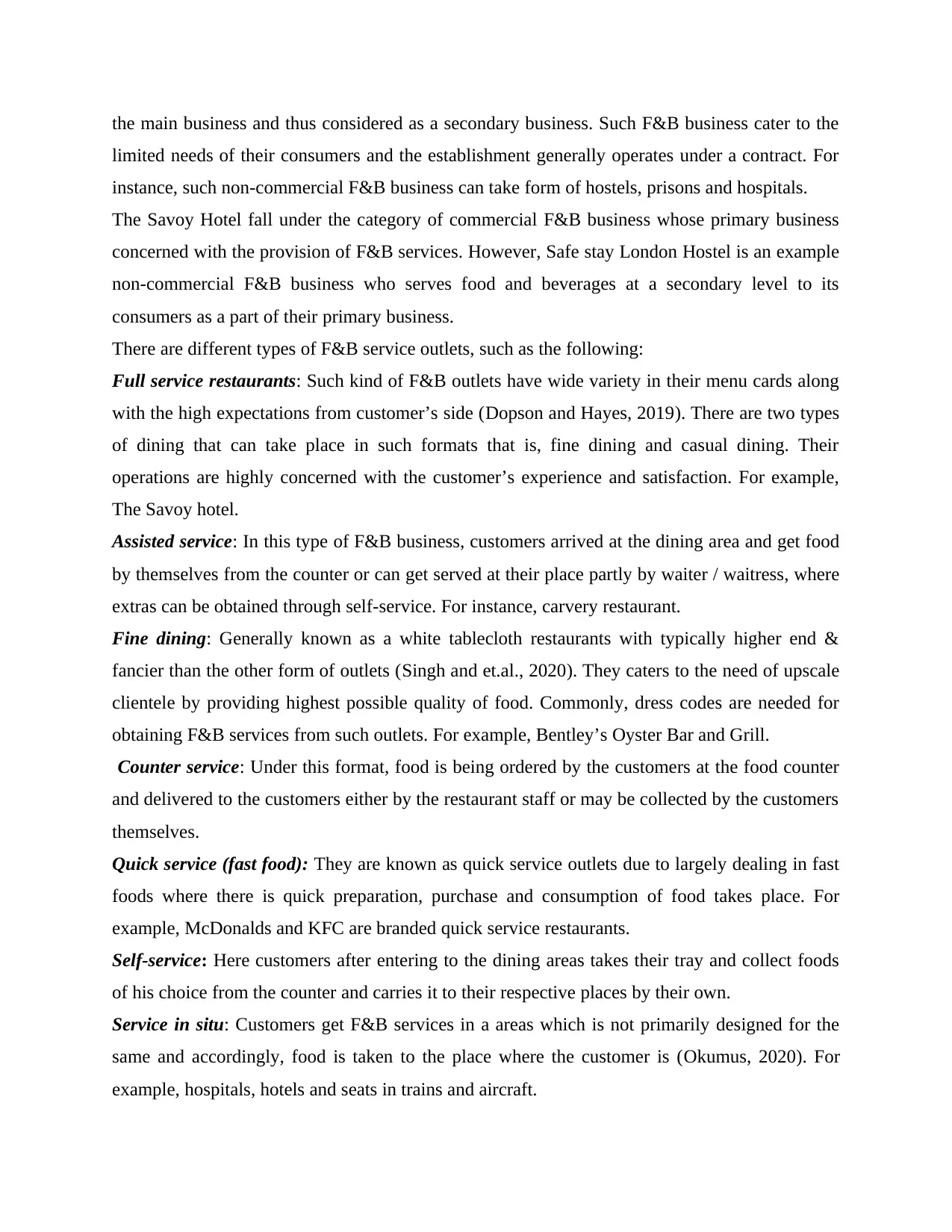
the main business and thus considered as a secondary business. Such F&B business cater to the
limited needs of their consumers and the establishment generally operates under a contract. For
instance, such non-commercial F&B business can take form of hostels, prisons and hospitals.
The Savoy Hotel fall under the category of commercial F&B business whose primary business
concerned with the provision of F&B services. However, Safe stay London Hostel is an example
non-commercial F&B business who serves food and beverages at a secondary level to its
consumers as a part of their primary business.
There are different types of F&B service outlets, such as the following:
Full service restaurants: Such kind of F&B outlets have wide variety in their menu cards along
with the high expectations from customer’s side (Dopson and Hayes, 2019). There are two types
of dining that can take place in such formats that is, fine dining and casual dining. Their
operations are highly concerned with the customer’s experience and satisfaction. For example,
The Savoy hotel.
Assisted service: In this type of F&B business, customers arrived at the dining area and get food
by themselves from the counter or can get served at their place partly by waiter / waitress, where
extras can be obtained through self-service. For instance, carvery restaurant.
Fine dining: Generally known as a white tablecloth restaurants with typically higher end &
fancier than the other form of outlets (Singh and et.al., 2020). They caters to the need of upscale
clientele by providing highest possible quality of food. Commonly, dress codes are needed for
obtaining F&B services from such outlets. For example, Bentley’s Oyster Bar and Grill.
Counter service: Under this format, food is being ordered by the customers at the food counter
and delivered to the customers either by the restaurant staff or may be collected by the customers
themselves.
Quick service (fast food): They are known as quick service outlets due to largely dealing in fast
foods where there is quick preparation, purchase and consumption of food takes place. For
example, McDonalds and KFC are branded quick service restaurants.
Self-service: Here customers after entering to the dining areas takes their tray and collect foods
of his choice from the counter and carries it to their respective places by their own.
Service in situ: Customers get F&B services in a areas which is not primarily designed for the
same and accordingly, food is taken to the place where the customer is (Okumus, 2020). For
example, hospitals, hotels and seats in trains and aircraft.
limited needs of their consumers and the establishment generally operates under a contract. For
instance, such non-commercial F&B business can take form of hostels, prisons and hospitals.
The Savoy Hotel fall under the category of commercial F&B business whose primary business
concerned with the provision of F&B services. However, Safe stay London Hostel is an example
non-commercial F&B business who serves food and beverages at a secondary level to its
consumers as a part of their primary business.
There are different types of F&B service outlets, such as the following:
Full service restaurants: Such kind of F&B outlets have wide variety in their menu cards along
with the high expectations from customer’s side (Dopson and Hayes, 2019). There are two types
of dining that can take place in such formats that is, fine dining and casual dining. Their
operations are highly concerned with the customer’s experience and satisfaction. For example,
The Savoy hotel.
Assisted service: In this type of F&B business, customers arrived at the dining area and get food
by themselves from the counter or can get served at their place partly by waiter / waitress, where
extras can be obtained through self-service. For instance, carvery restaurant.
Fine dining: Generally known as a white tablecloth restaurants with typically higher end &
fancier than the other form of outlets (Singh and et.al., 2020). They caters to the need of upscale
clientele by providing highest possible quality of food. Commonly, dress codes are needed for
obtaining F&B services from such outlets. For example, Bentley’s Oyster Bar and Grill.
Counter service: Under this format, food is being ordered by the customers at the food counter
and delivered to the customers either by the restaurant staff or may be collected by the customers
themselves.
Quick service (fast food): They are known as quick service outlets due to largely dealing in fast
foods where there is quick preparation, purchase and consumption of food takes place. For
example, McDonalds and KFC are branded quick service restaurants.
Self-service: Here customers after entering to the dining areas takes their tray and collect foods
of his choice from the counter and carries it to their respective places by their own.
Service in situ: Customers get F&B services in a areas which is not primarily designed for the
same and accordingly, food is taken to the place where the customer is (Okumus, 2020). For
example, hospitals, hotels and seats in trains and aircraft.
Secure Best Marks with AI Grader
Need help grading? Try our AI Grader for instant feedback on your assignments.
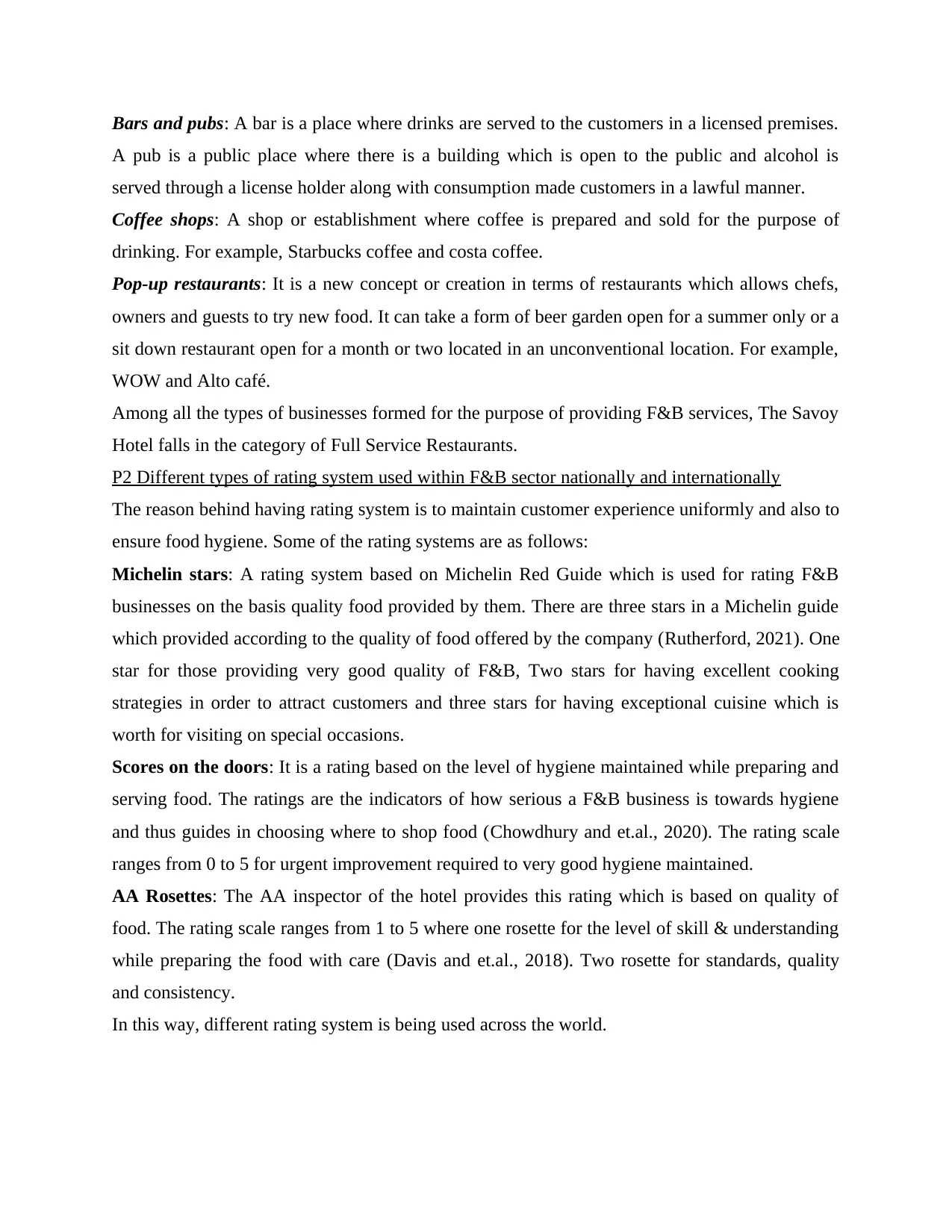
Bars and pubs: A bar is a place where drinks are served to the customers in a licensed premises.
A pub is a public place where there is a building which is open to the public and alcohol is
served through a license holder along with consumption made customers in a lawful manner.
Coffee shops: A shop or establishment where coffee is prepared and sold for the purpose of
drinking. For example, Starbucks coffee and costa coffee.
Pop-up restaurants: It is a new concept or creation in terms of restaurants which allows chefs,
owners and guests to try new food. It can take a form of beer garden open for a summer only or a
sit down restaurant open for a month or two located in an unconventional location. For example,
WOW and Alto café.
Among all the types of businesses formed for the purpose of providing F&B services, The Savoy
Hotel falls in the category of Full Service Restaurants.
P2 Different types of rating system used within F&B sector nationally and internationally
The reason behind having rating system is to maintain customer experience uniformly and also to
ensure food hygiene. Some of the rating systems are as follows:
Michelin stars: A rating system based on Michelin Red Guide which is used for rating F&B
businesses on the basis quality food provided by them. There are three stars in a Michelin guide
which provided according to the quality of food offered by the company (Rutherford, 2021). One
star for those providing very good quality of F&B, Two stars for having excellent cooking
strategies in order to attract customers and three stars for having exceptional cuisine which is
worth for visiting on special occasions.
Scores on the doors: It is a rating based on the level of hygiene maintained while preparing and
serving food. The ratings are the indicators of how serious a F&B business is towards hygiene
and thus guides in choosing where to shop food (Chowdhury and et.al., 2020). The rating scale
ranges from 0 to 5 for urgent improvement required to very good hygiene maintained.
AA Rosettes: The AA inspector of the hotel provides this rating which is based on quality of
food. The rating scale ranges from 1 to 5 where one rosette for the level of skill & understanding
while preparing the food with care (Davis and et.al., 2018). Two rosette for standards, quality
and consistency.
In this way, different rating system is being used across the world.
A pub is a public place where there is a building which is open to the public and alcohol is
served through a license holder along with consumption made customers in a lawful manner.
Coffee shops: A shop or establishment where coffee is prepared and sold for the purpose of
drinking. For example, Starbucks coffee and costa coffee.
Pop-up restaurants: It is a new concept or creation in terms of restaurants which allows chefs,
owners and guests to try new food. It can take a form of beer garden open for a summer only or a
sit down restaurant open for a month or two located in an unconventional location. For example,
WOW and Alto café.
Among all the types of businesses formed for the purpose of providing F&B services, The Savoy
Hotel falls in the category of Full Service Restaurants.
P2 Different types of rating system used within F&B sector nationally and internationally
The reason behind having rating system is to maintain customer experience uniformly and also to
ensure food hygiene. Some of the rating systems are as follows:
Michelin stars: A rating system based on Michelin Red Guide which is used for rating F&B
businesses on the basis quality food provided by them. There are three stars in a Michelin guide
which provided according to the quality of food offered by the company (Rutherford, 2021). One
star for those providing very good quality of F&B, Two stars for having excellent cooking
strategies in order to attract customers and three stars for having exceptional cuisine which is
worth for visiting on special occasions.
Scores on the doors: It is a rating based on the level of hygiene maintained while preparing and
serving food. The ratings are the indicators of how serious a F&B business is towards hygiene
and thus guides in choosing where to shop food (Chowdhury and et.al., 2020). The rating scale
ranges from 0 to 5 for urgent improvement required to very good hygiene maintained.
AA Rosettes: The AA inspector of the hotel provides this rating which is based on quality of
food. The rating scale ranges from 1 to 5 where one rosette for the level of skill & understanding
while preparing the food with care (Davis and et.al., 2018). Two rosette for standards, quality
and consistency.
In this way, different rating system is being used across the world.
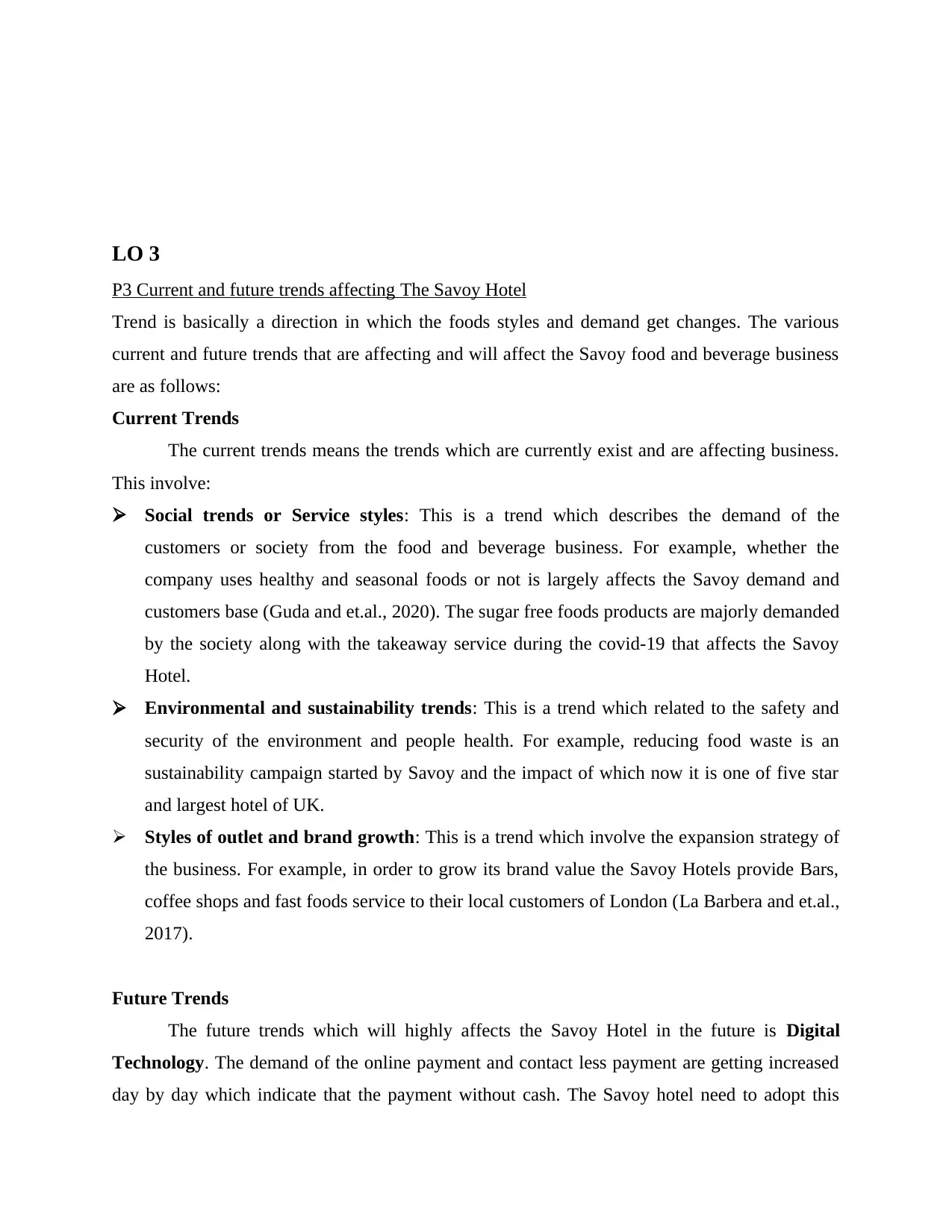
LO 3
P3 Current and future trends affecting The Savoy Hotel
Trend is basically a direction in which the foods styles and demand get changes. The various
current and future trends that are affecting and will affect the Savoy food and beverage business
are as follows:
Current Trends
The current trends means the trends which are currently exist and are affecting business.
This involve:
Social trends or Service styles: This is a trend which describes the demand of the
customers or society from the food and beverage business. For example, whether the
company uses healthy and seasonal foods or not is largely affects the Savoy demand and
customers base (Guda and et.al., 2020). The sugar free foods products are majorly demanded
by the society along with the takeaway service during the covid-19 that affects the Savoy
Hotel.
Environmental and sustainability trends: This is a trend which related to the safety and
security of the environment and people health. For example, reducing food waste is an
sustainability campaign started by Savoy and the impact of which now it is one of five star
and largest hotel of UK.
Styles of outlet and brand growth: This is a trend which involve the expansion strategy of
the business. For example, in order to grow its brand value the Savoy Hotels provide Bars,
coffee shops and fast foods service to their local customers of London (La Barbera and et.al.,
2017).
Future Trends
The future trends which will highly affects the Savoy Hotel in the future is Digital
Technology. The demand of the online payment and contact less payment are getting increased
day by day which indicate that the payment without cash. The Savoy hotel need to adopt this
P3 Current and future trends affecting The Savoy Hotel
Trend is basically a direction in which the foods styles and demand get changes. The various
current and future trends that are affecting and will affect the Savoy food and beverage business
are as follows:
Current Trends
The current trends means the trends which are currently exist and are affecting business.
This involve:
Social trends or Service styles: This is a trend which describes the demand of the
customers or society from the food and beverage business. For example, whether the
company uses healthy and seasonal foods or not is largely affects the Savoy demand and
customers base (Guda and et.al., 2020). The sugar free foods products are majorly demanded
by the society along with the takeaway service during the covid-19 that affects the Savoy
Hotel.
Environmental and sustainability trends: This is a trend which related to the safety and
security of the environment and people health. For example, reducing food waste is an
sustainability campaign started by Savoy and the impact of which now it is one of five star
and largest hotel of UK.
Styles of outlet and brand growth: This is a trend which involve the expansion strategy of
the business. For example, in order to grow its brand value the Savoy Hotels provide Bars,
coffee shops and fast foods service to their local customers of London (La Barbera and et.al.,
2017).
Future Trends
The future trends which will highly affects the Savoy Hotel in the future is Digital
Technology. The demand of the online payment and contact less payment are getting increased
day by day which indicate that the payment without cash. The Savoy hotel need to adopt this
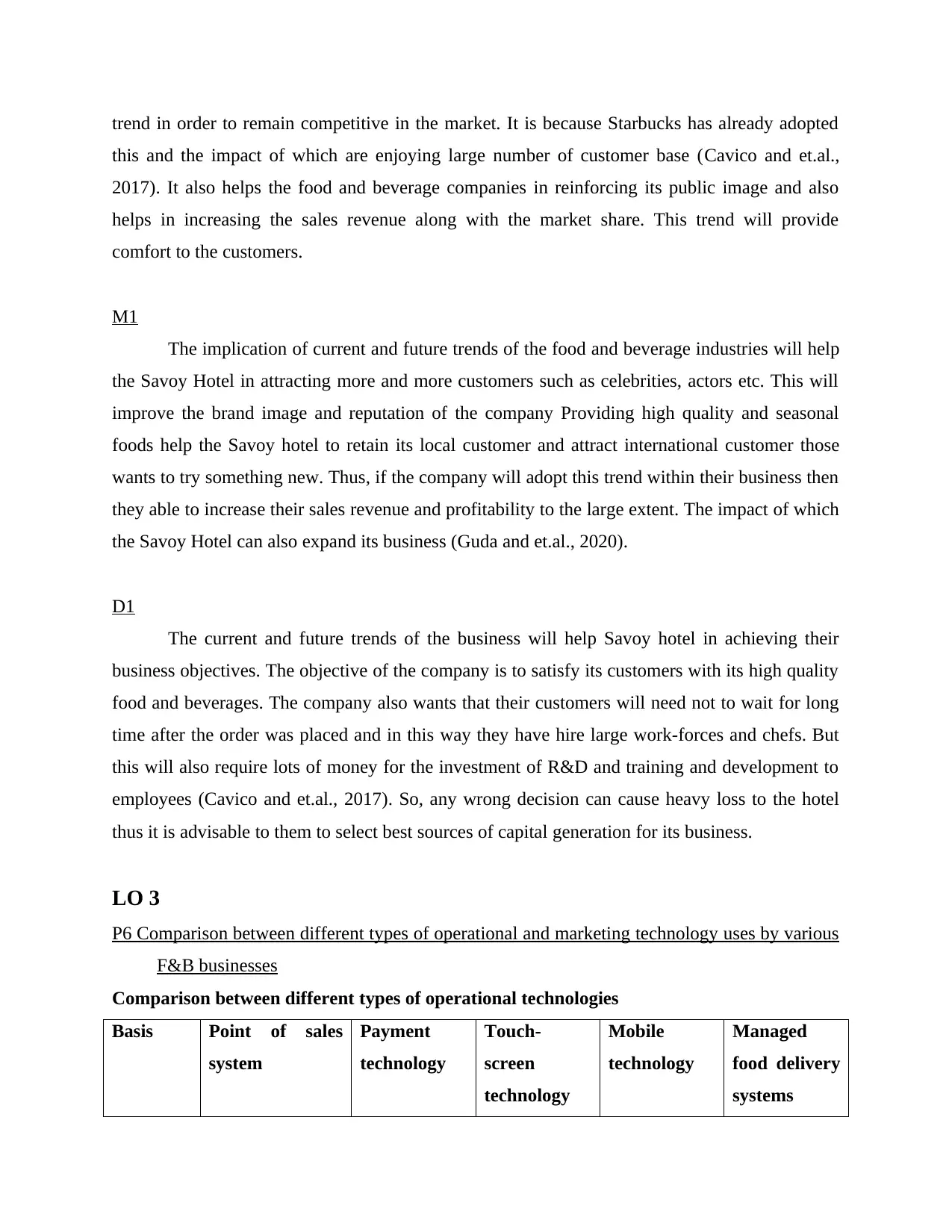
trend in order to remain competitive in the market. It is because Starbucks has already adopted
this and the impact of which are enjoying large number of customer base (Cavico and et.al.,
2017). It also helps the food and beverage companies in reinforcing its public image and also
helps in increasing the sales revenue along with the market share. This trend will provide
comfort to the customers.
M1
The implication of current and future trends of the food and beverage industries will help
the Savoy Hotel in attracting more and more customers such as celebrities, actors etc. This will
improve the brand image and reputation of the company Providing high quality and seasonal
foods help the Savoy hotel to retain its local customer and attract international customer those
wants to try something new. Thus, if the company will adopt this trend within their business then
they able to increase their sales revenue and profitability to the large extent. The impact of which
the Savoy Hotel can also expand its business (Guda and et.al., 2020).
D1
The current and future trends of the business will help Savoy hotel in achieving their
business objectives. The objective of the company is to satisfy its customers with its high quality
food and beverages. The company also wants that their customers will need not to wait for long
time after the order was placed and in this way they have hire large work-forces and chefs. But
this will also require lots of money for the investment of R&D and training and development to
employees (Cavico and et.al., 2017). So, any wrong decision can cause heavy loss to the hotel
thus it is advisable to them to select best sources of capital generation for its business.
LO 3
P6 Comparison between different types of operational and marketing technology uses by various
F&B businesses
Comparison between different types of operational technologies
Basis Point of sales
system
Payment
technology
Touch-
screen
technology
Mobile
technology
Managed
food delivery
systems
this and the impact of which are enjoying large number of customer base (Cavico and et.al.,
2017). It also helps the food and beverage companies in reinforcing its public image and also
helps in increasing the sales revenue along with the market share. This trend will provide
comfort to the customers.
M1
The implication of current and future trends of the food and beverage industries will help
the Savoy Hotel in attracting more and more customers such as celebrities, actors etc. This will
improve the brand image and reputation of the company Providing high quality and seasonal
foods help the Savoy hotel to retain its local customer and attract international customer those
wants to try something new. Thus, if the company will adopt this trend within their business then
they able to increase their sales revenue and profitability to the large extent. The impact of which
the Savoy Hotel can also expand its business (Guda and et.al., 2020).
D1
The current and future trends of the business will help Savoy hotel in achieving their
business objectives. The objective of the company is to satisfy its customers with its high quality
food and beverages. The company also wants that their customers will need not to wait for long
time after the order was placed and in this way they have hire large work-forces and chefs. But
this will also require lots of money for the investment of R&D and training and development to
employees (Cavico and et.al., 2017). So, any wrong decision can cause heavy loss to the hotel
thus it is advisable to them to select best sources of capital generation for its business.
LO 3
P6 Comparison between different types of operational and marketing technology uses by various
F&B businesses
Comparison between different types of operational technologies
Basis Point of sales
system
Payment
technology
Touch-
screen
technology
Mobile
technology
Managed
food delivery
systems
Paraphrase This Document
Need a fresh take? Get an instant paraphrase of this document with our AI Paraphraser
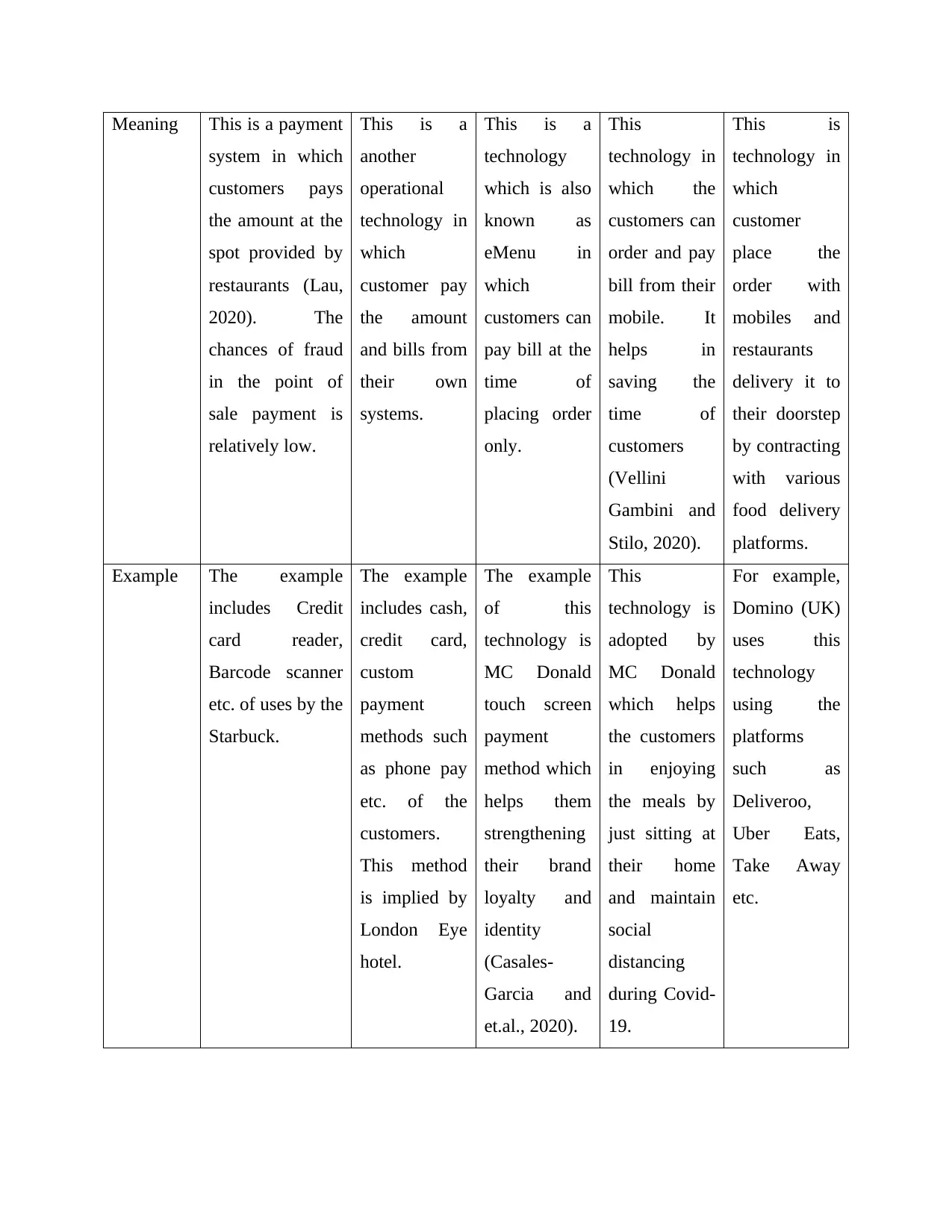
Meaning This is a payment
system in which
customers pays
the amount at the
spot provided by
restaurants (Lau,
2020). The
chances of fraud
in the point of
sale payment is
relatively low.
This is a
another
operational
technology in
which
customer pay
the amount
and bills from
their own
systems.
This is a
technology
which is also
known as
eMenu in
which
customers can
pay bill at the
time of
placing order
only.
This
technology in
which the
customers can
order and pay
bill from their
mobile. It
helps in
saving the
time of
customers
(Vellini
Gambini and
Stilo, 2020).
This is
technology in
which
customer
place the
order with
mobiles and
restaurants
delivery it to
their doorstep
by contracting
with various
food delivery
platforms.
Example The example
includes Credit
card reader,
Barcode scanner
etc. of uses by the
Starbuck.
The example
includes cash,
credit card,
custom
payment
methods such
as phone pay
etc. of the
customers.
This method
is implied by
London Eye
hotel.
The example
of this
technology is
MC Donald
touch screen
payment
method which
helps them
strengthening
their brand
loyalty and
identity
(Casales-
Garcia and
et.al., 2020).
This
technology is
adopted by
MC Donald
which helps
the customers
in enjoying
the meals by
just sitting at
their home
and maintain
social
distancing
during Covid-
19.
For example,
Domino (UK)
uses this
technology
using the
platforms
such as
Deliveroo,
Uber Eats,
Take Away
etc.
system in which
customers pays
the amount at the
spot provided by
restaurants (Lau,
2020). The
chances of fraud
in the point of
sale payment is
relatively low.
This is a
another
operational
technology in
which
customer pay
the amount
and bills from
their own
systems.
This is a
technology
which is also
known as
eMenu in
which
customers can
pay bill at the
time of
placing order
only.
This
technology in
which the
customers can
order and pay
bill from their
mobile. It
helps in
saving the
time of
customers
(Vellini
Gambini and
Stilo, 2020).
This is
technology in
which
customer
place the
order with
mobiles and
restaurants
delivery it to
their doorstep
by contracting
with various
food delivery
platforms.
Example The example
includes Credit
card reader,
Barcode scanner
etc. of uses by the
Starbuck.
The example
includes cash,
credit card,
custom
payment
methods such
as phone pay
etc. of the
customers.
This method
is implied by
London Eye
hotel.
The example
of this
technology is
MC Donald
touch screen
payment
method which
helps them
strengthening
their brand
loyalty and
identity
(Casales-
Garcia and
et.al., 2020).
This
technology is
adopted by
MC Donald
which helps
the customers
in enjoying
the meals by
just sitting at
their home
and maintain
social
distancing
during Covid-
19.
For example,
Domino (UK)
uses this
technology
using the
platforms
such as
Deliveroo,
Uber Eats,
Take Away
etc.
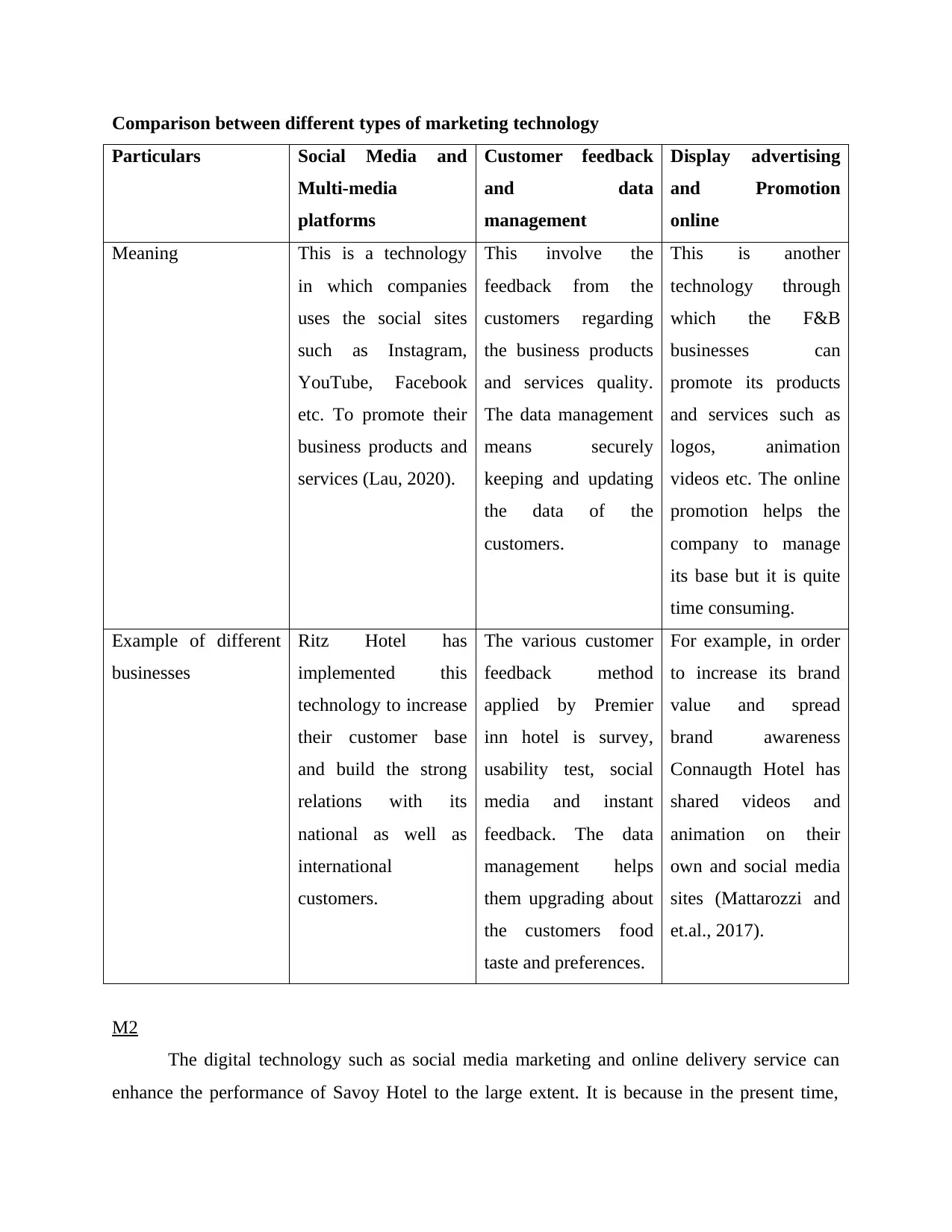
Comparison between different types of marketing technology
Particulars Social Media and
Multi-media
platforms
Customer feedback
and data
management
Display advertising
and Promotion
online
Meaning This is a technology
in which companies
uses the social sites
such as Instagram,
YouTube, Facebook
etc. To promote their
business products and
services (Lau, 2020).
This involve the
feedback from the
customers regarding
the business products
and services quality.
The data management
means securely
keeping and updating
the data of the
customers.
This is another
technology through
which the F&B
businesses can
promote its products
and services such as
logos, animation
videos etc. The online
promotion helps the
company to manage
its base but it is quite
time consuming.
Example of different
businesses
Ritz Hotel has
implemented this
technology to increase
their customer base
and build the strong
relations with its
national as well as
international
customers.
The various customer
feedback method
applied by Premier
inn hotel is survey,
usability test, social
media and instant
feedback. The data
management helps
them upgrading about
the customers food
taste and preferences.
For example, in order
to increase its brand
value and spread
brand awareness
Connaugth Hotel has
shared videos and
animation on their
own and social media
sites (Mattarozzi and
et.al., 2017).
M2
The digital technology such as social media marketing and online delivery service can
enhance the performance of Savoy Hotel to the large extent. It is because in the present time,
Particulars Social Media and
Multi-media
platforms
Customer feedback
and data
management
Display advertising
and Promotion
online
Meaning This is a technology
in which companies
uses the social sites
such as Instagram,
YouTube, Facebook
etc. To promote their
business products and
services (Lau, 2020).
This involve the
feedback from the
customers regarding
the business products
and services quality.
The data management
means securely
keeping and updating
the data of the
customers.
This is another
technology through
which the F&B
businesses can
promote its products
and services such as
logos, animation
videos etc. The online
promotion helps the
company to manage
its base but it is quite
time consuming.
Example of different
businesses
Ritz Hotel has
implemented this
technology to increase
their customer base
and build the strong
relations with its
national as well as
international
customers.
The various customer
feedback method
applied by Premier
inn hotel is survey,
usability test, social
media and instant
feedback. The data
management helps
them upgrading about
the customers food
taste and preferences.
For example, in order
to increase its brand
value and spread
brand awareness
Connaugth Hotel has
shared videos and
animation on their
own and social media
sites (Mattarozzi and
et.al., 2017).
M2
The digital technology such as social media marketing and online delivery service can
enhance the performance of Savoy Hotel to the large extent. It is because in the present time,
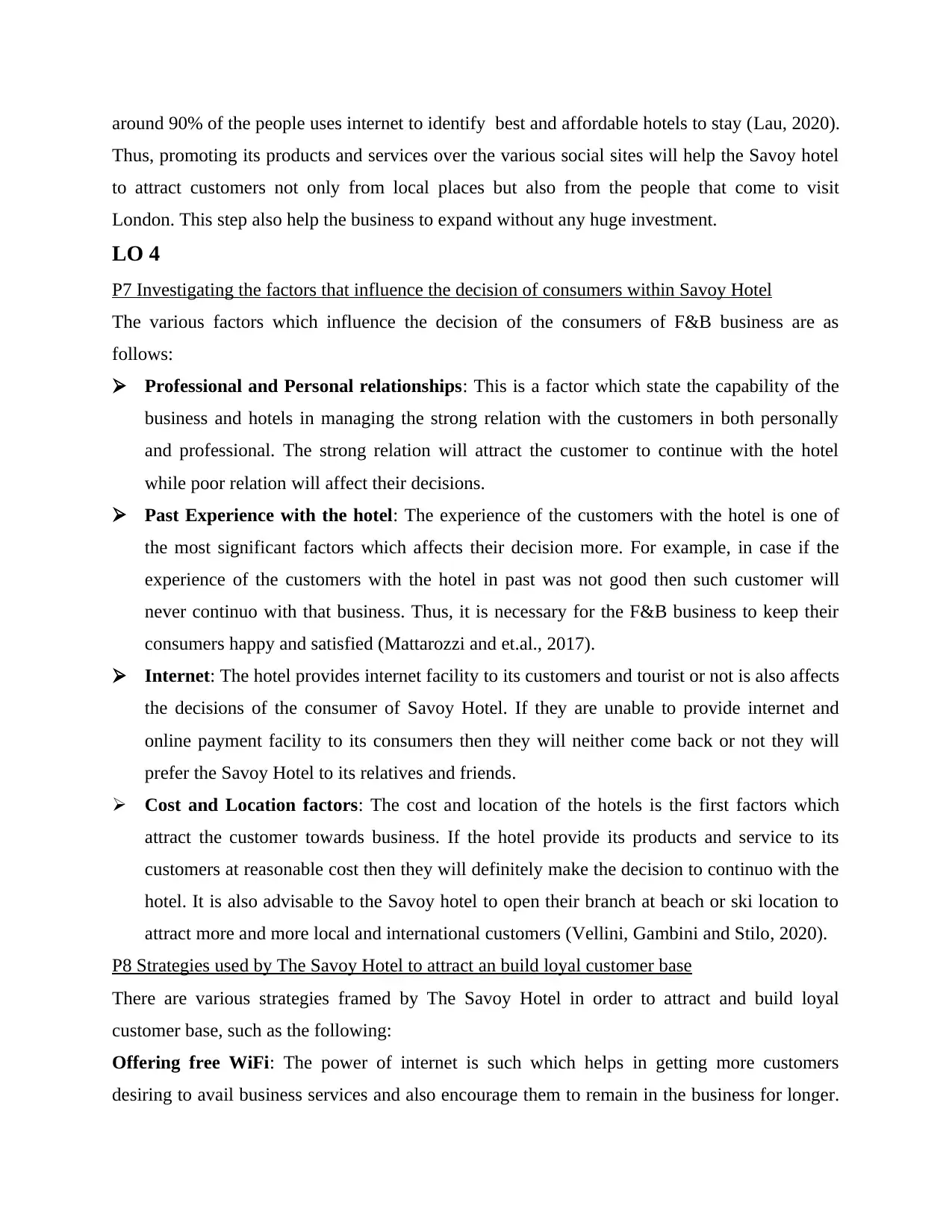
around 90% of the people uses internet to identify best and affordable hotels to stay (Lau, 2020).
Thus, promoting its products and services over the various social sites will help the Savoy hotel
to attract customers not only from local places but also from the people that come to visit
London. This step also help the business to expand without any huge investment.
LO 4
P7 Investigating the factors that influence the decision of consumers within Savoy Hotel
The various factors which influence the decision of the consumers of F&B business are as
follows:
Professional and Personal relationships: This is a factor which state the capability of the
business and hotels in managing the strong relation with the customers in both personally
and professional. The strong relation will attract the customer to continue with the hotel
while poor relation will affect their decisions.
Past Experience with the hotel: The experience of the customers with the hotel is one of
the most significant factors which affects their decision more. For example, in case if the
experience of the customers with the hotel in past was not good then such customer will
never continuo with that business. Thus, it is necessary for the F&B business to keep their
consumers happy and satisfied (Mattarozzi and et.al., 2017).
Internet: The hotel provides internet facility to its customers and tourist or not is also affects
the decisions of the consumer of Savoy Hotel. If they are unable to provide internet and
online payment facility to its consumers then they will neither come back or not they will
prefer the Savoy Hotel to its relatives and friends.
Cost and Location factors: The cost and location of the hotels is the first factors which
attract the customer towards business. If the hotel provide its products and service to its
customers at reasonable cost then they will definitely make the decision to continuo with the
hotel. It is also advisable to the Savoy hotel to open their branch at beach or ski location to
attract more and more local and international customers (Vellini, Gambini and Stilo, 2020).
P8 Strategies used by The Savoy Hotel to attract an build loyal customer base
There are various strategies framed by The Savoy Hotel in order to attract and build loyal
customer base, such as the following:
Offering free WiFi: The power of internet is such which helps in getting more customers
desiring to avail business services and also encourage them to remain in the business for longer.
Thus, promoting its products and services over the various social sites will help the Savoy hotel
to attract customers not only from local places but also from the people that come to visit
London. This step also help the business to expand without any huge investment.
LO 4
P7 Investigating the factors that influence the decision of consumers within Savoy Hotel
The various factors which influence the decision of the consumers of F&B business are as
follows:
Professional and Personal relationships: This is a factor which state the capability of the
business and hotels in managing the strong relation with the customers in both personally
and professional. The strong relation will attract the customer to continue with the hotel
while poor relation will affect their decisions.
Past Experience with the hotel: The experience of the customers with the hotel is one of
the most significant factors which affects their decision more. For example, in case if the
experience of the customers with the hotel in past was not good then such customer will
never continuo with that business. Thus, it is necessary for the F&B business to keep their
consumers happy and satisfied (Mattarozzi and et.al., 2017).
Internet: The hotel provides internet facility to its customers and tourist or not is also affects
the decisions of the consumer of Savoy Hotel. If they are unable to provide internet and
online payment facility to its consumers then they will neither come back or not they will
prefer the Savoy Hotel to its relatives and friends.
Cost and Location factors: The cost and location of the hotels is the first factors which
attract the customer towards business. If the hotel provide its products and service to its
customers at reasonable cost then they will definitely make the decision to continuo with the
hotel. It is also advisable to the Savoy hotel to open their branch at beach or ski location to
attract more and more local and international customers (Vellini, Gambini and Stilo, 2020).
P8 Strategies used by The Savoy Hotel to attract an build loyal customer base
There are various strategies framed by The Savoy Hotel in order to attract and build loyal
customer base, such as the following:
Offering free WiFi: The power of internet is such which helps in getting more customers
desiring to avail business services and also encourage them to remain in the business for longer.
Secure Best Marks with AI Grader
Need help grading? Try our AI Grader for instant feedback on your assignments.
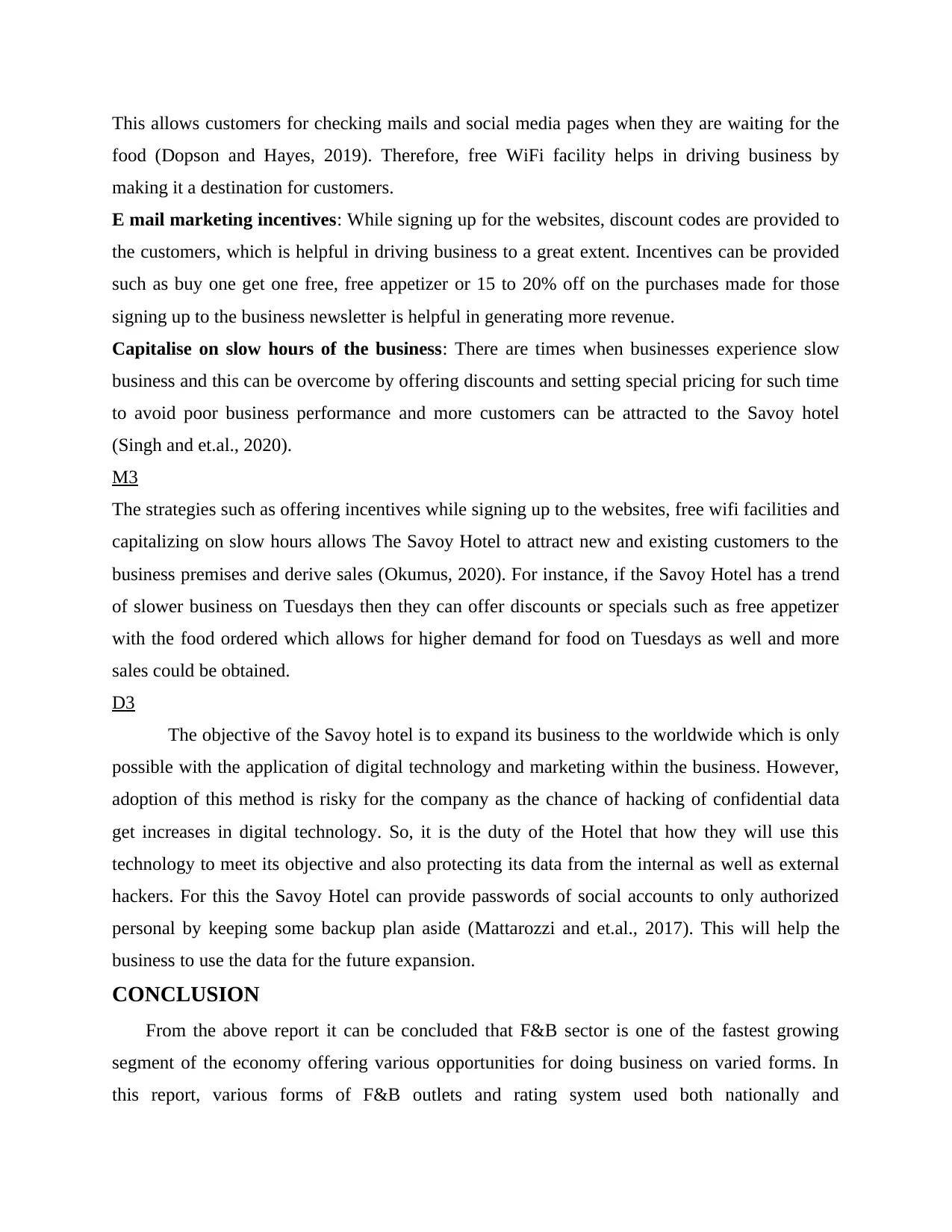
This allows customers for checking mails and social media pages when they are waiting for the
food (Dopson and Hayes, 2019). Therefore, free WiFi facility helps in driving business by
making it a destination for customers.
E mail marketing incentives: While signing up for the websites, discount codes are provided to
the customers, which is helpful in driving business to a great extent. Incentives can be provided
such as buy one get one free, free appetizer or 15 to 20% off on the purchases made for those
signing up to the business newsletter is helpful in generating more revenue.
Capitalise on slow hours of the business: There are times when businesses experience slow
business and this can be overcome by offering discounts and setting special pricing for such time
to avoid poor business performance and more customers can be attracted to the Savoy hotel
(Singh and et.al., 2020).
M3
The strategies such as offering incentives while signing up to the websites, free wifi facilities and
capitalizing on slow hours allows The Savoy Hotel to attract new and existing customers to the
business premises and derive sales (Okumus, 2020). For instance, if the Savoy Hotel has a trend
of slower business on Tuesdays then they can offer discounts or specials such as free appetizer
with the food ordered which allows for higher demand for food on Tuesdays as well and more
sales could be obtained.
D3
The objective of the Savoy hotel is to expand its business to the worldwide which is only
possible with the application of digital technology and marketing within the business. However,
adoption of this method is risky for the company as the chance of hacking of confidential data
get increases in digital technology. So, it is the duty of the Hotel that how they will use this
technology to meet its objective and also protecting its data from the internal as well as external
hackers. For this the Savoy Hotel can provide passwords of social accounts to only authorized
personal by keeping some backup plan aside (Mattarozzi and et.al., 2017). This will help the
business to use the data for the future expansion.
CONCLUSION
From the above report it can be concluded that F&B sector is one of the fastest growing
segment of the economy offering various opportunities for doing business on varied forms. In
this report, various forms of F&B outlets and rating system used both nationally and
food (Dopson and Hayes, 2019). Therefore, free WiFi facility helps in driving business by
making it a destination for customers.
E mail marketing incentives: While signing up for the websites, discount codes are provided to
the customers, which is helpful in driving business to a great extent. Incentives can be provided
such as buy one get one free, free appetizer or 15 to 20% off on the purchases made for those
signing up to the business newsletter is helpful in generating more revenue.
Capitalise on slow hours of the business: There are times when businesses experience slow
business and this can be overcome by offering discounts and setting special pricing for such time
to avoid poor business performance and more customers can be attracted to the Savoy hotel
(Singh and et.al., 2020).
M3
The strategies such as offering incentives while signing up to the websites, free wifi facilities and
capitalizing on slow hours allows The Savoy Hotel to attract new and existing customers to the
business premises and derive sales (Okumus, 2020). For instance, if the Savoy Hotel has a trend
of slower business on Tuesdays then they can offer discounts or specials such as free appetizer
with the food ordered which allows for higher demand for food on Tuesdays as well and more
sales could be obtained.
D3
The objective of the Savoy hotel is to expand its business to the worldwide which is only
possible with the application of digital technology and marketing within the business. However,
adoption of this method is risky for the company as the chance of hacking of confidential data
get increases in digital technology. So, it is the duty of the Hotel that how they will use this
technology to meet its objective and also protecting its data from the internal as well as external
hackers. For this the Savoy Hotel can provide passwords of social accounts to only authorized
personal by keeping some backup plan aside (Mattarozzi and et.al., 2017). This will help the
business to use the data for the future expansion.
CONCLUSION
From the above report it can be concluded that F&B sector is one of the fastest growing
segment of the economy offering various opportunities for doing business on varied forms. In
this report, various forms of F&B outlets and rating system used both nationally and
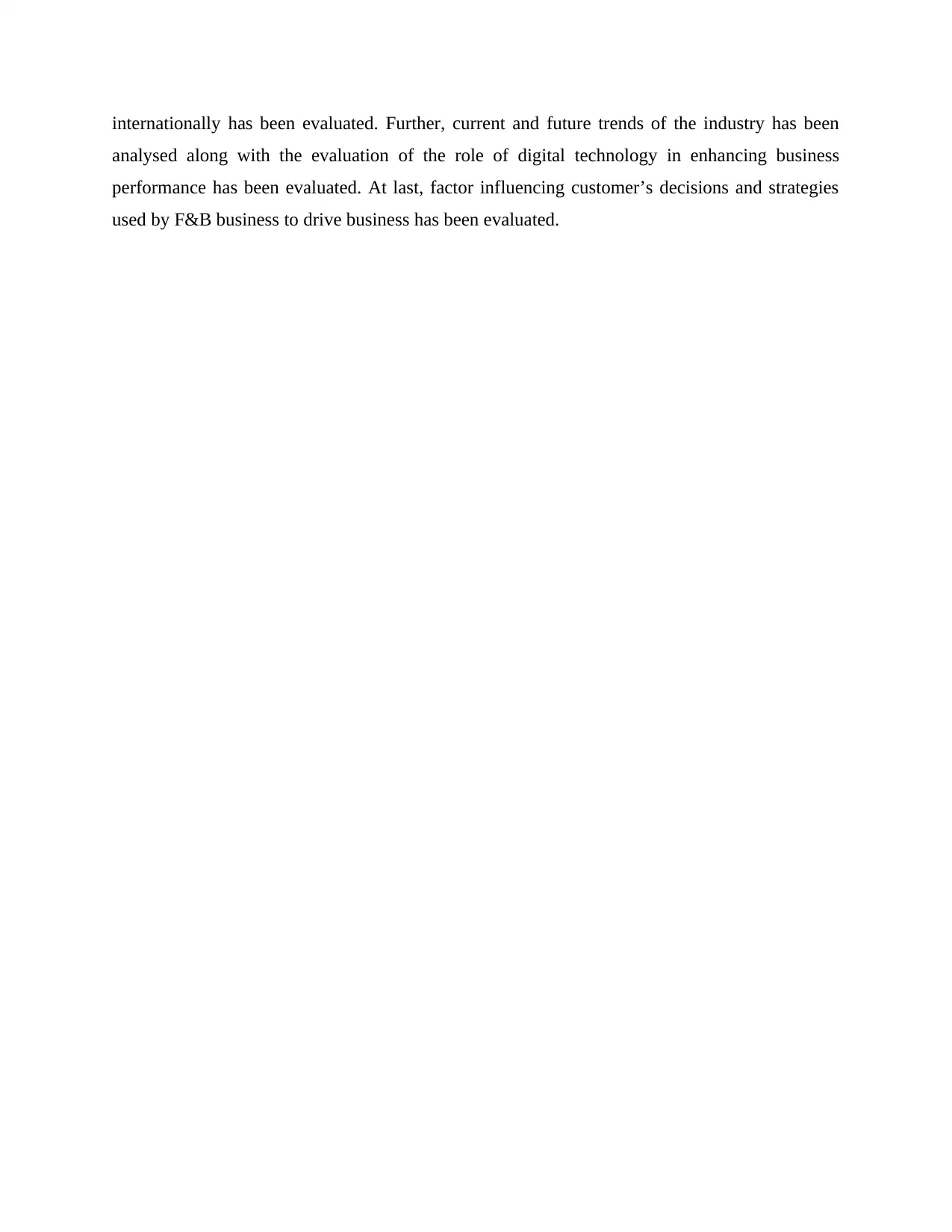
internationally has been evaluated. Further, current and future trends of the industry has been
analysed along with the evaluation of the role of digital technology in enhancing business
performance has been evaluated. At last, factor influencing customer’s decisions and strategies
used by F&B business to drive business has been evaluated.
analysed along with the evaluation of the role of digital technology in enhancing business
performance has been evaluated. At last, factor influencing customer’s decisions and strategies
used by F&B business to drive business has been evaluated.
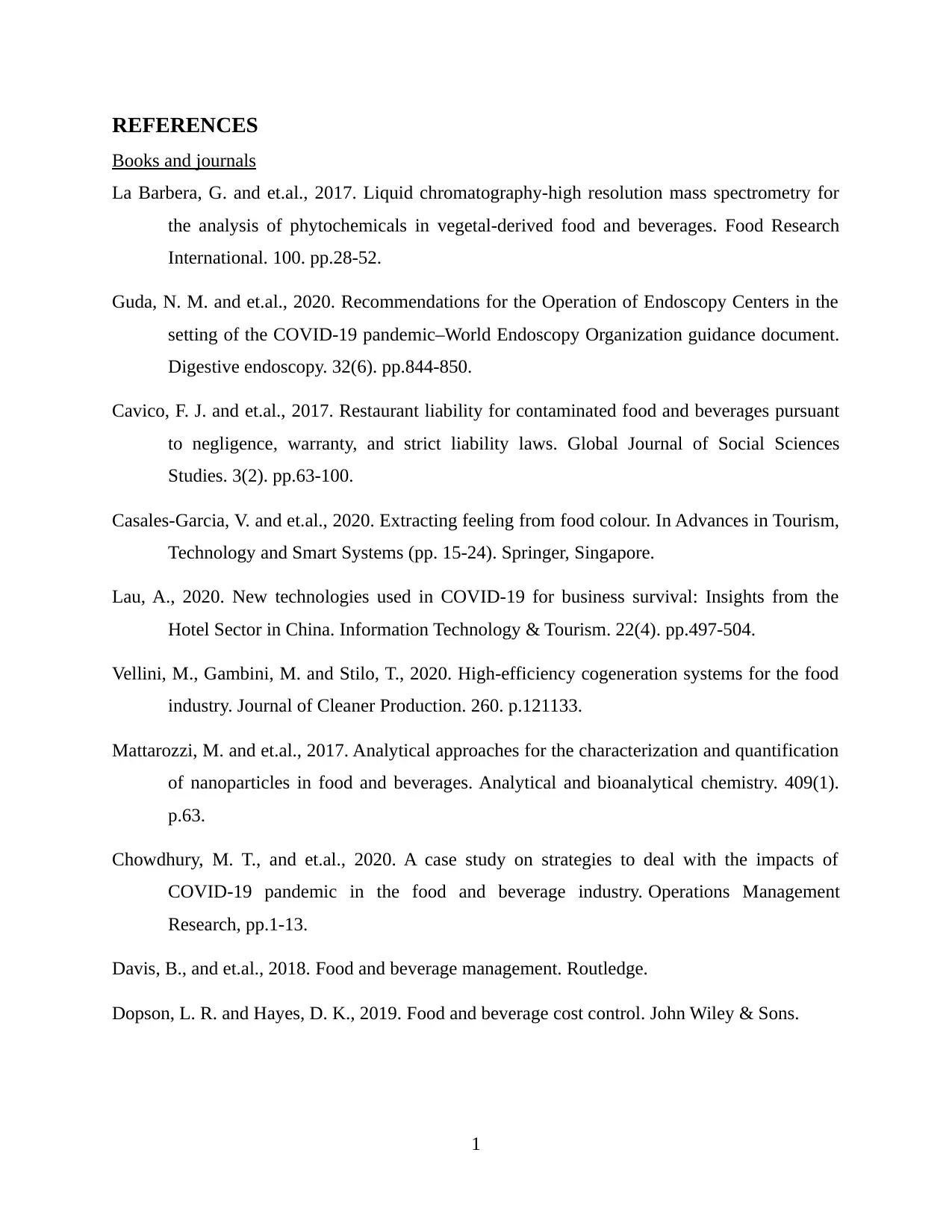
REFERENCES
Books and journals
La Barbera, G. and et.al., 2017. Liquid chromatography-high resolution mass spectrometry for
the analysis of phytochemicals in vegetal-derived food and beverages. Food Research
International. 100. pp.28-52.
Guda, N. M. and et.al., 2020. Recommendations for the Operation of Endoscopy Centers in the
setting of the COVID‐19 pandemic–World Endoscopy Organization guidance document.
Digestive endoscopy. 32(6). pp.844-850.
Cavico, F. J. and et.al., 2017. Restaurant liability for contaminated food and beverages pursuant
to negligence, warranty, and strict liability laws. Global Journal of Social Sciences
Studies. 3(2). pp.63-100.
Casales-Garcia, V. and et.al., 2020. Extracting feeling from food colour. In Advances in Tourism,
Technology and Smart Systems (pp. 15-24). Springer, Singapore.
Lau, A., 2020. New technologies used in COVID-19 for business survival: Insights from the
Hotel Sector in China. Information Technology & Tourism. 22(4). pp.497-504.
Vellini, M., Gambini, M. and Stilo, T., 2020. High-efficiency cogeneration systems for the food
industry. Journal of Cleaner Production. 260. p.121133.
Mattarozzi, M. and et.al., 2017. Analytical approaches for the characterization and quantification
of nanoparticles in food and beverages. Analytical and bioanalytical chemistry. 409(1).
p.63.
Chowdhury, M. T., and et.al., 2020. A case study on strategies to deal with the impacts of
COVID-19 pandemic in the food and beverage industry. Operations Management
Research, pp.1-13.
Davis, B., and et.al., 2018. Food and beverage management. Routledge.
Dopson, L. R. and Hayes, D. K., 2019. Food and beverage cost control. John Wiley & Sons.
1
Books and journals
La Barbera, G. and et.al., 2017. Liquid chromatography-high resolution mass spectrometry for
the analysis of phytochemicals in vegetal-derived food and beverages. Food Research
International. 100. pp.28-52.
Guda, N. M. and et.al., 2020. Recommendations for the Operation of Endoscopy Centers in the
setting of the COVID‐19 pandemic–World Endoscopy Organization guidance document.
Digestive endoscopy. 32(6). pp.844-850.
Cavico, F. J. and et.al., 2017. Restaurant liability for contaminated food and beverages pursuant
to negligence, warranty, and strict liability laws. Global Journal of Social Sciences
Studies. 3(2). pp.63-100.
Casales-Garcia, V. and et.al., 2020. Extracting feeling from food colour. In Advances in Tourism,
Technology and Smart Systems (pp. 15-24). Springer, Singapore.
Lau, A., 2020. New technologies used in COVID-19 for business survival: Insights from the
Hotel Sector in China. Information Technology & Tourism. 22(4). pp.497-504.
Vellini, M., Gambini, M. and Stilo, T., 2020. High-efficiency cogeneration systems for the food
industry. Journal of Cleaner Production. 260. p.121133.
Mattarozzi, M. and et.al., 2017. Analytical approaches for the characterization and quantification
of nanoparticles in food and beverages. Analytical and bioanalytical chemistry. 409(1).
p.63.
Chowdhury, M. T., and et.al., 2020. A case study on strategies to deal with the impacts of
COVID-19 pandemic in the food and beverage industry. Operations Management
Research, pp.1-13.
Davis, B., and et.al., 2018. Food and beverage management. Routledge.
Dopson, L. R. and Hayes, D. K., 2019. Food and beverage cost control. John Wiley & Sons.
1
Paraphrase This Document
Need a fresh take? Get an instant paraphrase of this document with our AI Paraphraser
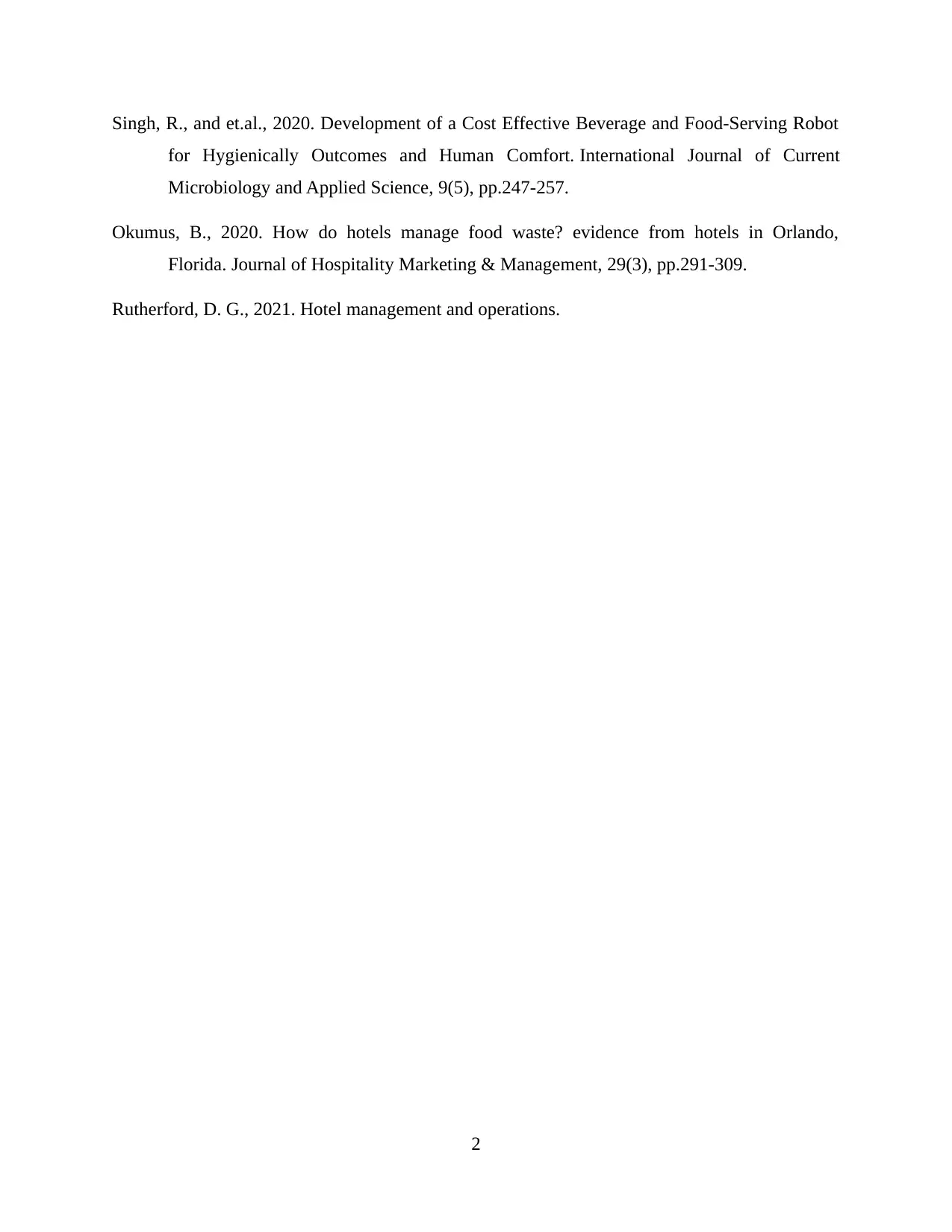
Singh, R., and et.al., 2020. Development of a Cost Effective Beverage and Food-Serving Robot
for Hygienically Outcomes and Human Comfort. International Journal of Current
Microbiology and Applied Science, 9(5), pp.247-257.
Okumus, B., 2020. How do hotels manage food waste? evidence from hotels in Orlando,
Florida. Journal of Hospitality Marketing & Management, 29(3), pp.291-309.
Rutherford, D. G., 2021. Hotel management and operations.
2
for Hygienically Outcomes and Human Comfort. International Journal of Current
Microbiology and Applied Science, 9(5), pp.247-257.
Okumus, B., 2020. How do hotels manage food waste? evidence from hotels in Orlando,
Florida. Journal of Hospitality Marketing & Management, 29(3), pp.291-309.
Rutherford, D. G., 2021. Hotel management and operations.
2
1 out of 14
Related Documents
Your All-in-One AI-Powered Toolkit for Academic Success.
+13062052269
info@desklib.com
Available 24*7 on WhatsApp / Email
![[object Object]](/_next/static/media/star-bottom.7253800d.svg)
Unlock your academic potential
© 2024 | Zucol Services PVT LTD | All rights reserved.




